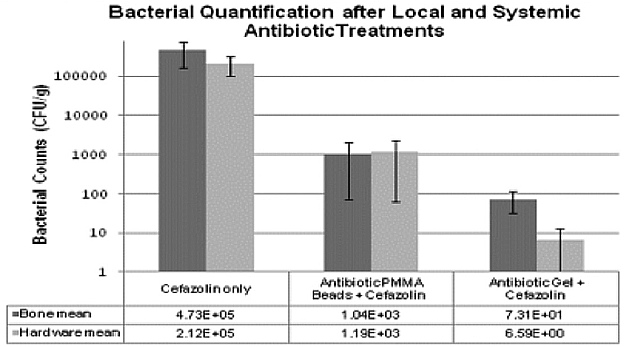
Fri., 10/5/12 Basic Science, PAPER #53, 1:29 pm OTA-2012
Eradication of Wound Contamination Is Improved by Synergistic Effects of Local and Systemic Antibiotic Delivery.
Ben C.C. Rand, MRCS1,2; Jowan G. Penn-Barwell, MRCS1,2; Joseph C. Wenke, PhD1;
1U.S. Army Institute of Surgical Research, Fort Sam Houston, Texas, USA;
2Academic Department of Military Surgery and Trauma, Royal Centre for Defense Medicine, Birmingham, United Kingdom
Background/Purpose: Eradication of contaminating bacteria to a level manageable to the host immune system is vital in preventing chronic infection and its complications. Appropriate use of systemic antibiotics reduces infection rates in open fractures but local delivery can deliver higher doses to the wound without toxic systemic effects and may further reduce infection. We wished to quantify the effect in combination to confirm the synergy presumed by clinicians. Although the gold standard for local antibiotic delivery is with impregnated polymethylmethacrylate (PMMA) beads, a biodegradable vehicle would be better, negating the need for additional surgery required with beads. Our hypothesis was that an investigational biodegradable antibiotic gel would have a superior synergistic effect to antibiotic PMMA beads, when used in conjunction with systemic antibiotics.
Methods: An established rat open fracture model with a Staphylococcus aureus–contaminated critical-sized femoral defect was used. The wounds were débrided and irrigated 6 hours after contamination and the animals were assigned to one of three groups, all of which received systemic antibiotics: antibiotic gel, antibiotic PMMA beads, and the no local delivery control group. DFA-02 is an investigational phospholipid vehicle containing 1.7% vancomycin and 1.9% gentamicin by weight that has been shown to be more effective than beads used as a sole therapy. PMMA beads contained vancomycin and tobramycin (the aminoglycoside used in PMMA beads in the U.S.). Systemic antibiotics (cefazolin 2 mg/kg twice daily) were commenced at the time of débridement surgery and were continued for 3 days postoperatively. At 2 weeks from initial surgery, the animals were euthanized, the femur and hardware were stripped of soft tissue, and bacterial levels were quantified using standard microbiologic analysis.
Results: Local antibiotics used in combination with systemic were superior (P <0.05) to systemic antibiotics alone. Between antibiotic gel and PMMA bead groups there was no statistically significant difference when used with systemic antibiotics; however, there was two orders of magnitude fewer bacteria in the hardware group.

Conclusion: These results suggest that local antibiotics can add value to systemic antibiotic use. Previous work demonstrated that the antibiotic gel was much more effective than antibiotic beads in this preclinical model without use of systemic antibiotics; it appears that systemic antibiotic administration slightly blunts the differences between beads and gel. While the difference between PMMA bead and gel treatment groups is not significant in this model with systemic antibiotics, gel offers handling advantages due to its ready to use formulation and biodegradable nature.
Animal Statement: This study has been conducted in compliance with the Animal Welfare act, the implementing Animal Welfare Regulations, and the principles of the Guide for the Care and Use of Laboratory Animals.
Disclaimer: The opinions and assertions contained herein are the private views of the authors and are not to be construed as official or as reflecting the views of the Department of the Army or Department of Defense. Dr. Reddy’s Laboratories Ltd. kindly donated the experimental material for use in this study.
Alphabetical Disclosure Listing (808K PDF)
• The FDA has not cleared this drug and/or medical device for the use described in this presentation (i.e., the drug or medical device is being discussed for an “off label” use). ◆FDA information not available at time of printing. Δ OTA Grant.